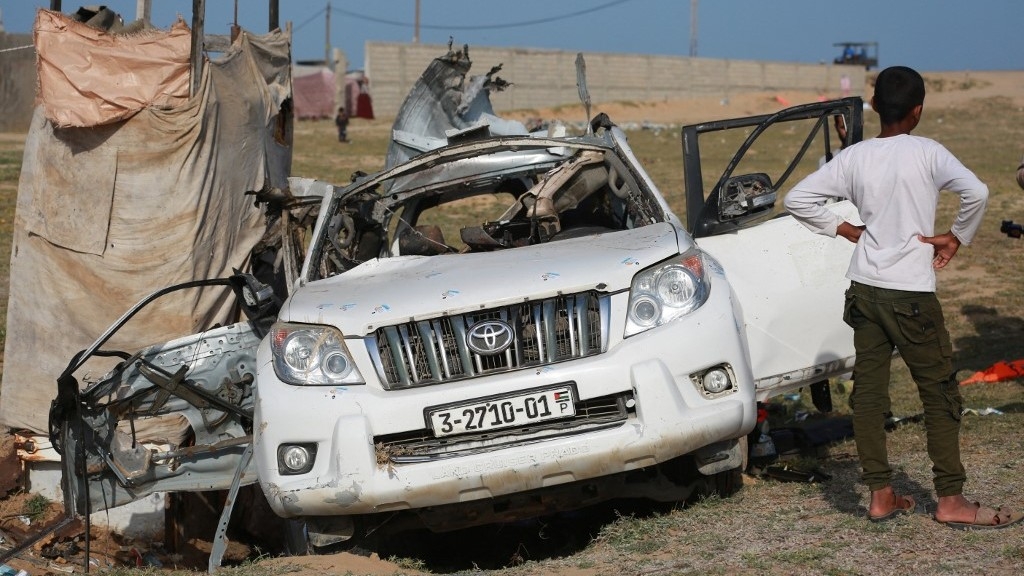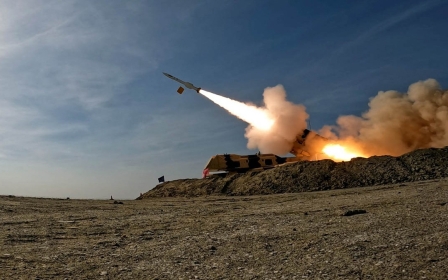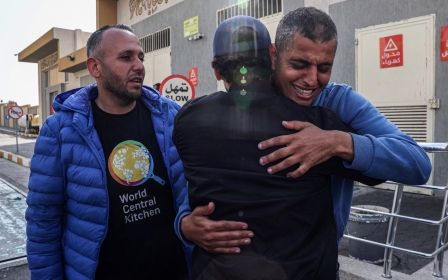Over 350 humanitarian sites and aid convoys hit in Gaza since 7 October

At least 357 humanitarian-run sites and convoys in Gaza whose coordinates had been shared in advance with warring parties were hit before the World Central Kitchen (WCK) attack this month, Middle East Eye has learnt.
UN officials and aid workers, many speaking on condition of anonymity, have told MEE it had been clear for months that the humanitarian notification system in Gaza was broken.
But when the Israeli military killed seven aid workers, including six foreigners, in the WCK convoy on 1 April, the flawed system came under global scrutiny.
Israeli Defence Minister Yoav Gallant announced the establishment of a new humanitarian deconfliction cell to ensure the security of aid workers. US Ambassador Jack Lew was given a tour.
Yet two weeks on from the attack, Jamie McGoldrick, the UN's outgoing top aid official working in Gaza told MEE on Saturday that "nothing substantive" had changed in the way humanitarians share their locations with the Israeli military to protect themselves.
New MEE newsletter: Jerusalem Dispatch
Sign up to get the latest insights and analysis on Israel-Palestine, alongside Turkey Unpacked and other MEE newsletters
McGoldrick also told reporters on Friday, his last day in the post, that aid organisations need a hotline to communicate directly with the Israeli military during emergencies and equipment such as two-way radios and satellite phones, items which are standard for aid workers in other conflicts, but not in Gaza where Israel fears they could be seized by Hamas.
“All we can do is keep pressing them for that,” McGoldrick said, of Israeli concessions made since the attack.
The majority of the hits to deconfliction humanitarian sites - 352 - were to locations run by Unrwa, the largest aid organisation operating in Gaza, including a food distribution centre and schools sheltering thousands of civilians.
Collating publicised accounts, MEE has counted five additional locations and convoys of other humanitarian organisations whose coordinates had been shared were also hit.
'Every single day we are discussing internally whether to leave Gaza. We should not be there'
- Brice de la Vingne, MSF
They include a compound in Al-Mawasi housing staff working for the International Rescue Committee and Medical Aid for Palestine, the Gaza City offices of Doctors of the World, a Medecins Sans Frontieres (MSF) convoy in Gaza City and an MSF shelter in Al-Mawasi, and an American Near East Refugee (ANERA) shelter in Deir al-Balah.
The WCK attack brought the toll of aid workers killed in Gaza since 7 October to at least 216, the vast majority of whom were Palestinians killed by aerial bombardment, according to figures compiled by the Aid Worker Security Database.
Aid workers who spoke to MEE said the scale of incidents was unprecedented, even compared to the most dangerous war zones and emergencies they have experienced.
“To be frank, every single day we are discussing internally whether to leave Gaza. We should not be there,” said Brice de la Vingne, MSF's head of emergency unit. “The level of risk we are taking, I’ve never seen.”
Beyond the impact on the lives of aid workers and their families, an insecure deconfliction system means that aid distribution, which is already hugely problematic in Gaza even as famine sets in, is disrupted.
After the attack, WCK - which had been providing more hot meals in Gaza than the World Food Programme and Unrwa combined - and Anera both suspended their operations.
"Between us we are trying to push back this famine and stop it in its tracks. But it's a team effort," the World Food Programme told MEE soon after the attack. "It will only work if all of us are able to do our work and do it safely."
Density and intensity
Humanitarian sites and personnel, like civilians, are protected under international humanitarian law. Sharing coordinates with parties to a conflict does not offer any further legal protection, but serves to make it easier for warring parties to steer clear of hitting these locations.
At least in theory. But humanitarians say the density of Gaza, paired with the intensity - and many would argue the indiscriminate nature - of Israel's campaign in Gaza which has seen more than 33,000 Palestinians killed, has made the already difficult process of humanitarian deconfliction extremely challenging.
“Something people don’t understand is that humanitarian organisations don’t operate inside the battlefield normally,” de la Vingne said.
In Ukraine, for instance, he said all of MSF’s operations run out of the reach of artillery. In Mosul, during the campaign against the Islamic State (IS) militant group, MSF had a large surgical unit and other activities close to the frontline, but outside of IS-controlled territory.
“In Gaza, we are in this nightmarish hell scenario where we are working in an environment where people are not supposed to be,” de la Vingne said.
Aid organisations who have had deconflicted sites and convoys hit express frustration over the lack of clarity - or even response - from the Israeli military about the incidents.
The International Rescue Committee and Medical Aid for Palestine said last month that Israeli officials had offered six different explanations about why an F-16 jet hit their stand-alone compound with a 1,000-pound "smart bomb" early on the morning of 18 January, weeks after its coordinates had been shared.
“It is clear from this experience that the Israeli military and government are either unable or unwilling to properly investigate this serious incident,” the organisations said at the time.
Given that aid organisations share coordinates digitally, there will presumably be a paper trail that could give some clues about who received those details and when, and if how and to whom they were passed on.
No direct contact
Without detail about what, how and when decisions were taken, experts say it’s hard to know exactly where and why the deconfliction system in Gaza has failed.
But those currently involved in humanitarian deconfliction in Gaza say they believe communication breakdowns - both between humanitarians and Israel, and in the Israeli chain of command - are a major factor.
“There have been too many incidents of the deconfliction system not working, be it system failures or human error,” McGoldrick told MEE in an interview earlier this month, days after the WCK attack.
In other conflicts, the UN would normally have direct communication with any military controlling an area, McGoldrick said.
At the height of the Saudi-led coalition campaign in Yemen, he said the UN had face-to-face conversations online with the Saudis, allowing information about movements and complications to be shared in real time.
'There have been too many incidents of the deconfliction system not working'
- Jamie McGoldrick, UN
In 2006, during the war between Israel and Hezbollah in Lebanon, a senior UN humanitarian was embedded in the Israeli military operations room “deconflicting the deconfliction”, McGoldrick said.
But that’s not the case now: the UN doesn’t speak directly to the Israeli military, but to Cogat, the Israeli agency that oversees the Palestinian territories, and to the Civilian Liaison Administration, a subdivision of Cogat focused on Gaza.
If there is a serious security incident - at a checkpoint or enroute to a destination for example - there is no way to communicate directly with the Israeli military.
“We need to have a conversation with them directly,” McGoldrick said.
The UN, he added, should have pushed harder earlier in the conflict to get closer to the Israeli military, if not physically embedding someone in a joint operations room, then at least being able to have a face-to-face conversation online, in real time.
“That way, you can have two things happen,” he said. “First, they understand better what you do and how you do it. Secondly, you can build trust in terms of what your expectations are on both sides.”
During earlier wars in Gaza, UN and Cogat officials would meet almost daily to discuss plans for the next 24 hours, Grisha Yakubovich, the former head of Cogat until 2016, told the Washington Post this month.
According to the Post, Yakubovich suggested that no longer happens because of the Israeli military’s reluctance to work with Unrwa. In late January, Israel accused 12 Unrwa staff members of being involved in the Hamas-led attacks on 7 October.
McGoldrick acknowledged there is “a great deal of mistrust with the UN” on the Israeli side. His predecessor, Lynn Hastings, was effectively forced out of the role in December when Israel foreign ministry officials refused to renew her visa, citing lost “trust and confidence”.
He said he had stepped into his role temporarily “not just to improve the operations, but also to build a different relationship with Israel”.
“It hasn’t been easy, but I think we are making some progress,” he said.
Deconfliction cell
The new humanitarian deconfliction cell, announced by the Israeli defence minister, was among topics McGoldrick told journalists he discussed last week with Major General Yaron Finkelman who heads the Israeli military’s Southern Command.
McGoldrick said it was the first meeting with the Israeli military since he started his role in late December.
“We talked very openly about some of the things that are missing,” he said, adding that he was hopeful the conversation would help “because [Finkelman] said he sees us not against them”.
But as of Saturday, McGoldrick told MEE nothing substantive had changed in the efforts to fix deconfliction, noting a Unicef convoy, carrying high-energy foods and fuel, was hit with bullets at a checkpoint last Tuesday.
Unicef had shared its coordinates and received clearance before starting towards to northern Gaza where it was scheduled, among other stops, to visit Kamal Adwan Hospital where children are dying from malnutrition.
Tess Ingram, a Unicef spokesperson who was part of the convoy, said they were approaching the Wadi Gaza checkpoint, one of the main routes into northern Gaza, when gunfire broke out.
Ingram told NPR it wasn’t clear who made the shots. “We just know that it came from the direction of the checkpoint towards civilians, and there didn't seem to be any fire returned,” she said.
After the incident, Israeli forces refused to allow the convoy to continue.
“We’re not going to give up,” Ingram said. “We’re going to try again hopefully later on this week.”
De la Vingne said MSF has yet to receive any calls from Israeli officials about the announced deconfliction cell.
“Since that announcement, there has been no contact from their side, no initiative, no nothing,” he said.
The Israeli military did not respond when asked when the cell, with humanitarians and the military in one room, would be operational.
Middle East Eye delivers independent and unrivalled coverage and analysis of the Middle East, North Africa and beyond. To learn more about republishing this content and the associated fees, please fill out this form. More about MEE can be found here.






